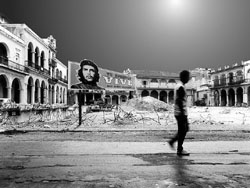The Cuban painter Vicente Bonachea
once said to me: the only thing Cubans take seriously is the absurd.
Cuba is not just any country, it is the last existing socialist tropical
paradise, anachronistic, absurd, dadaistic and surrealistic. The system´s
logic is that there is no logic at all. A country far from any rational
comprehension.
Cuba is on top of a volcano which is going to erupt the day Fidel Castro
dies at the latest. But even today it seems like you can literally hear
a cry for change. However, this cry is suppressed by a strange and, at the
same time, weird silence. Everybody seems to be waiting for something but
no-one even knows for what. Cuba doesn't live, it survives.
But how to get the Cuban reality into a picture? How to document the absurd?
These questions lead to some elementary reflections about documentary photography:
the idea of a photo being a genuine image of reality has in fact existed
since the beginning of photography. Documentary photography in particular
has an aura of truth which is the result of its general image: that's how
it was! Until today, the myth of objective photographic presentation suppressed
any subjective aspect of photography. Our visual perception is based on
the fact that we believe what we see, especially when it comes to documentary
photography. With the advent of new technologies, especially the digital
processing of photos, our visual perception is getting mixed up. Finally.
Already the public has been confronted with digital technology to quite
a high degree which has confused our understanding of perception. The digital
(r)evolution procedes quite fast. This arouses an oppressive feeling of
insecurity for those who take the pictures as well as for those who look
at them. There is a lack of experience and also of binding judgement criterions
in handling the digital picture world. The natural trust is going to disappear.
As a matter of fact, documentary pictures are no longer real or true. The
decisive element of a documentary photo is not the authenticity of the moment,
but the symbol of the message. Digital techniques help by advancing a new
understanding of photography as such.
The digital change of a picture adds a new level of perception to it that
did not exist in the analog picture. This raises the question, particularly
with documentary photography: is a photo which has been changed digitally
less true or even fake? From my point of view it is not, in fact the contrary
is the case.
We must not forget that the interpretation of a picture takes place in our
heads. The meaning of what we see is never what we see but what it means
to us. Pictures are not to concretize reality but to interpret. That is
why the question is not about whether or not it is legitimate to manipulate
documentary photos but how.
A precondition, however, is that any digital change becomes obvious and
duplicatable after having taken a closer look. And that's the point. Digitally
manipulated documentary photos without any sign of manipulation don't give
any hint to the viewer to question his perception. However, a picture that,
on first sight, seems to be without contradiction in its appearance and
content, yet contradicts the viewer's knowledge and experience after having
taken a closer look, is a challenge to both the photographer and the viewer.
The message he gets first seems to be true and he believes what he sees.
However, then he has to think about his first impression and he obtains
new information different from the first and seeming truth. He finally comes
to the conclusion that, "It can´t possibly have been that way."
Which was exactly my impression during my journey through Cuba. It can`t
possibly have been that way. But it has been that way...
Michael Najjar
Michael Najjar can be
reached at: mn@ledesi.de
|



